
William Tolliver, 1951-2000
Big Band.
About:
William Tolliver spent more than 38 of his 48 years perfecting his skill as an artist. It all began when he was about seven; his mother would conduct art contests between herself, Tolliver and his older brother to see who could draw the best. Although his brothers’ interest in art waned, Tolliver’s never did, it only got stronger. Relocating from Lafayette, La. in 1991, he opened a gallery in the district of Buckhead in Atlanta, Ga. He remained there until 1997.
Learning to Play, 1996.
The Vicksburg, MS native handled figure studies, portraits, human interest situations, landscapes, and semi-abstracts, all with equal perfection and all from a photographic memory. He never received any formal training, however, Tolliver attested to reading more than 4,000 books on different subjects, but mostly on art – his thirst for the subject was unquenchable. He educated himself by studying the classics: Chagall, Monet, Van Gogh and Picasso.
Delta Blues.
At 13, while studying the classics, Tolliver noticed that his lines and style were very much like that of Picasso. Picasso was an avid appreciator of African art. The style Picasso used, cubism, was taken from African art. He spent a lot of time in African museums and developed an African style (cubism) “I knew my lines were like Picasso’s but it wasn’t until later I knew why.” Cubism was not the only style Tolliver used. He incorporated abstract, realism, and impressionism with his own techniques. He used them all like tools to create the different elements in his paintings.
Jazz Band.
Among his many achievements, Tolliver works have travelled with the Smithsonian Museum of Art and he was commissioned by the Olympic Games Committee to create a piece (depicting the “Spirit of Georgia”) for the 1996 Olympic Games held in Atlanta, GA.
Art demands a response, whether it’s good or bad – that was Tolliver’s objective. When looking at his work, one is sure to respond – to the artist’s creative and vivid use of colors, his composition, lines or subject. In all of those areas, he demonstrated the God-Given talent that he discovered early in life.(text and copyright Tolliver Estate)



